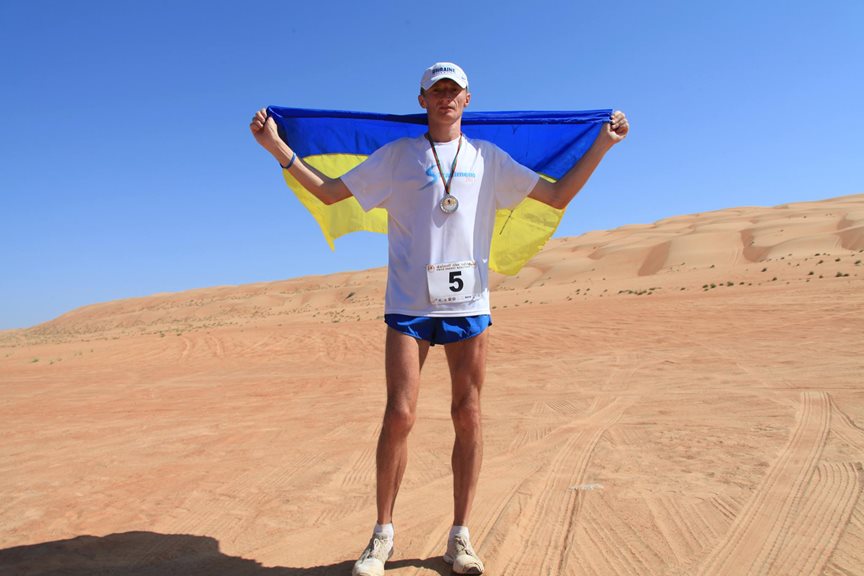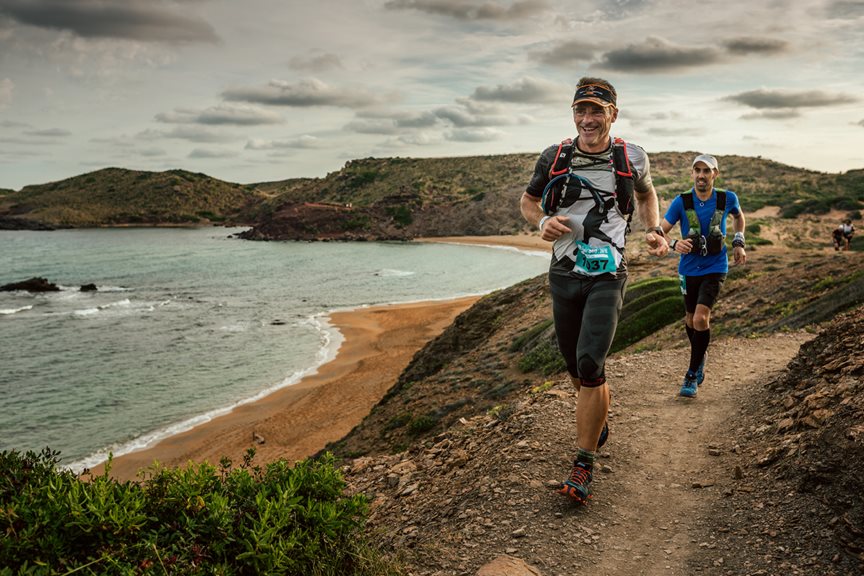Last updated: 06-Nov-18
By Ian Corless
IC: So, 2010 comes around and you get that slot in the Marathon des Sables. There’s some amazing footage of you in a heat chamber with Ahansal*. You almost double the other guy in size. Did this make you think maybe you were better suited to colder conditions than a really hot one?
JC: We trained in the heat chamber; ironically eight months earlier was the chamber I was training in at –40C. I went for 2 days at +50C running on the treadmill head-to-head with Ahansal. He lost hardly anything in sweat whereas I lost three kilos in one hour. It made me realise that I needed more time adjusting. Also, Ahansal is built like a running whippet.
*Mohamad Ahansal is a multiple winner of the Marathon des Sables
IC: Well you can’t always be the best at everything! So Marathon de Sables was a really interesting project for you to take on and. It almost became part personal project, part science project. There was a lot of testing going on and there was analysing of food, calorie requirements and hydration needs. How was it for you having everything tested? Do you find it problematic at times or do you know it’s of great benefit to you?
JC: I think looking back on it we could have done better. Body weight was key and I should have been light, in rowing a general rule is a good big one will beat a great little one. This is the first time for me when I realised running a marathon and carrying your kit that ‘weight’ would make a massive difference.
It’s a game of balancing weight, calories and hydration to maximize performance. The human body is phenomenal and for me lining up on the start and having faith that my body wouldn’t let me down was important, James is a great athlete, he’s got gold medals, he’s done this and he’s done that but he’s a big guy to get through the Sahara.
IC: You really worked for that 12th place and there were points when it looked like you weren’t getting up again. So how does the race compare to everything you have done?
JC: I don’t know if I surprised people because that relies on people being honest with you. The thing that is different about that race is that it’s not your ability to perform one day but multiple days. When you’re hungry and tired, that’s when your performance and your ability in a multi stage race shines.
People said to me be prepared for the long day. I thought no point in taking it easy and being fresh for the long day. What if I am out of the race for taking it too slow? I pushed everyday. I remember going down in the medical tent and them trying to put a drip in me and something clicked in my head… I got up saying no drip, no drip! Funny.
IC: I know lots of people in the ultra world and having seen your journey at Marathon des Sables and your ability to push yourself to a point where many other people wouldn’t be able to. When that race was going on how much information were you getting from the team that was doing all the filming and analysing? Obviously we could see footage in the documentary of the testing; did they help? Did they tell you that you were not drinking enough and that you had a real problem with dehydration and so on?
JC: I told the team that I didn’t want to be told anything because I felt it was unfair on the people I was competing against. It’s the same reason I didn’t cheat at the Olympics because I would know I had cheated, so yeah, I couldn’t live with myself if I knew I had come 12th with an extra litre of water or a chocolate bar.
I did make a complaint to the race officials that everyone had the same amount of water even though I’m twice the size. So I had to commit to the plan I had set myself. I had made some intelligent decisions before the race to test things out. It’s all about faith that you have enough food, warmth and equipment to see you through the days.
IC: Marathon des Sables is imminent, what advice would you give to people who are going or may contemplate the race in the future?
JC: You can get too modern about it. Keep it simple. Many sport supplements are sweet and you get so sick of sweet things. For example, carbohydrate per gram is about four calories whereas fat per gram is nine calories and cheese is a lot fattier, so for the same weight you’re getting a lot more calories and it tastes really strong. Take some Parmesan cheese and also I would also take some jerky as it’s full of protein and takes a while to eat.
IC: I’ve got to say I’m completely agreeing with you on that, so with the Marathon des Sables done, what followed?
JC: The next big thing was America, and the multi sport adventure.
IC: This was all to be done in 18 days, yes?
JC: It was brilliant, a great way to see America. The mental maths, the varied terrain and the combination of multiple sports were amazing. However, in the end it had a bigger change on my life than I had expected. I had run Death Valley, which was about 80 miles in 17 hours. I think I drank 38 litres of liquid and still lost kilos in weight. It was horrendously hot. After that section it was 5 days of cycling eating up many, many miles. However, one morning I got hit by a truck on route 66! I was hit on the back off the head and I woke up in hospital a month later.
IC: Needless to say it was a completely horrendous time. I think back and nobody really knew, yourself and your family what was going to happen? I am pleased to say that you came out of the other side but it’s not been easy. One of the things that you were proactive about is that you were wearing a cycle helmet, which prevented you from being killed in the accident.
JC: The wing mirror from the lorry hit the back of my head as it passed me, if I wasn’t wearing the helmet…
IC: How do you come out from the other side of that? We all might have our thought processes and ideas about how you pulled through. For you and Beverly and your children, that process was completely different, and of course you wrote the book with your wife. What was that period like?
JC: My injury is something that not that many people have to have an understanding of, you become a different person, it exaggerates you like the volume has been turned up. It’s an incredibly different situation but through my eyes everything was ok with people treating me weird. I’d gone from a normal human to a subgroup of person with a brain injury, I still have no sense of taste or smell, I can taste sugar or salt that’s it. It’s been a hell of a process. My wife had to put up with the fact I may die and then me pulling through with severe brain injury. At the same time she had found out she was pregnant with our second child. I know I couldn’t have dealt with that like she did.
IC: That was four years ago, time has passed. Healing time for you and your family. You are now in a better place, a place that will allow you to move on in a sports perspective. In June this year you’re going to be be heading out to South Africa to take place in the Richtersveld Wildrun, a 4-day race. It’s a little bit like Marathon des Sables but you don’t have to carry your own kit. How cathartic is that race going to be, going back to something that you succeeded at previously, that’s very similar to Marathon des Sables?
JC: Marathon des Sables is the only multi-stage running race I’ve done so it will be nice to see if it was or wasn’t a fluke. I also need to see who I am and see if my body has recovered, so many questions. As with anything that lasts multiple days, I want to know how I cope after day one.
IC: Have you been to South Africa before?
JC: Yeah, I’ve been a number of times; the first was the sports tour to oppose ‘apartheid’. Phenomenally varied country in terms of mountains to safari and plains to surf breaks, it’s a really great place to be.
IC: Do you know anything about the race area?
JC: No, I don’t know much about the rural Cape at all.
IC: There are deserts, rocks and climbing. You’re going to be covering about a marathon a day for four days, so that is going to get you into shape. You have got to pull your finger out between now and then. If that goes well, 2015 is also going to be a comeback year for you with Death Valley. You are setting goals for yourself, potentially going back to Death Valley to race Badwater 135. What does that mean to you, James, to get the opportunity to go there and run after your horrific accident?
JC: I’d love the chance to do it. The race in the Cape will let me know if I’m on track to do that. You have to make the right decisions at the right time. It will be about me drawing a line after the accident as well and moving on. It will be nice to go back to Death Valley and put some demons to rest. I need to square the circle and move on.
I don’t want my life to be defined by winning two gold medals. I don’t want my life to be defined by being the guy who got hit on the head by a truck! I refuse, I will choose my path and I will not be pigeon holed. I will create my path.
Read part one of this interview here.
MDS 2010. Photo credit: Mark Gillett-Jungelemoon
Images ©jamescracknell and MDS images ©markgillett/junglemoon_
You can follow James at Richtersveld Wildrun on iancorless.com and on Twitter @talkultra
About the Richtersveld Wildrun™
The 150km Richtersveld Wildrun™ takes place in the /Ai/Ais-Richtersveld Transfrontier Park over four days from 2 to 5 June 2015. Wildrun™ stage races have become known as some of Southern Africa’s premier multi-day trail running events, and Owen Middleton, founder and managing director of the organising company, Wildrunner, is proud to see the interest in Wildrun™ events shaping up internationally, particularly with top-class runners such as Kimball and James Cracknell.





